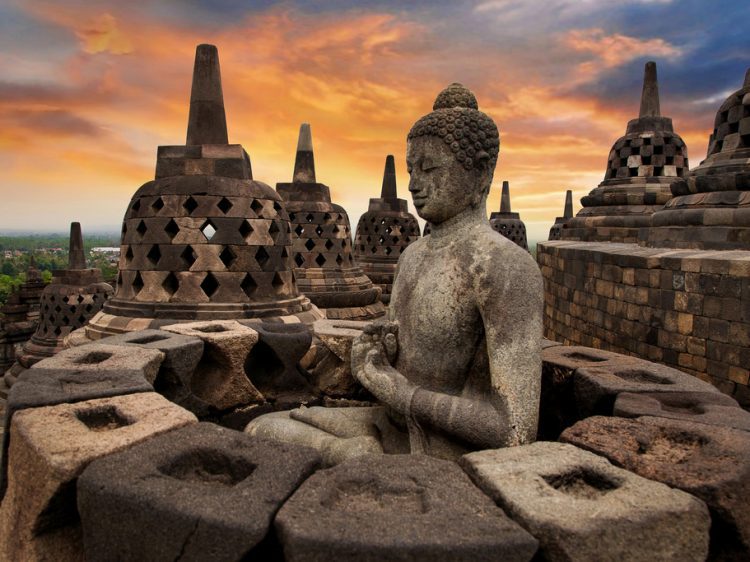Since its inception, Borobudur Temple has become one of the most popular destinations in Magelang, Central Java. The condition is still well maintained, so that it still functions as a place of worship, especially during Waisak.
Unfortunately, until now it has not been revealed how the process of the formation of the largest Buddhist temple in the world. However, there are some interesting and unique facts about Borobudur Temple that you should know. Including the following:
1. Borobudur temple was built between the 8th century
Based on written characters, the construction of Borobudur Temple is estimated to have been carried out between the 8th and 9th centuries. It took 75-100 years to complete during the reign of King Samaratungga.
Unfortunately, there is no concrete evidence regarding the main reason the Borobudur Temple was built. As the development of the Islamic empire in Java, Borobudur Temple began to be abandoned in the 14th century.
2. Borobudur Temple was found by the Governor General of England
The British Governor General in Java, Sir Thomas Stamford Raffles, discovered Borobudur Temple in 1814. He wrote this story in a book entitled The History of Java or the History of the Island of Java.
On his orders, H.C Cornelius was assigned to clean the area of Borobudur Temple for study. Slowly but surely, eventually many parties wanted to save the Borobudur Temple site.
3. Borobudur Temple consists of two million volcanic blocks
There are many debates about Borobudur, including the hypothesis that the temple was built on an ancient lake that dried up. The suspicion is getting stronger when there is evidence of submerging of the base of the temple in the 13th and 14th centuries. However, until now the construction of Borobudur Temple is still a mystery.
One thing that is certain is that the Borobudur Temple consists of two million well-sculpted volcanic blocks. Each beam interlocked, so that the temple remains strong until now.
4. Borobudur Temple was about to be demolished to be stored in a museum
Behind the splendor of Borobudur Temple, many artefact hunters are interested in collecting them. The head of the statue is the most popular part. Therefore, many Buddha statues have been found without heads.
To make matters worse, the Dutch East Indies Government also gave it voluntarily in 1896. Five statues of Buddha along with 30 stones with 30 relief stones, two lions, statues of guards, stones in the form of stairs, etc. were given to the King of Thailand, Chulalongkorn. You can see this collection at the Bangkok National Museum.
The rampant theft at that time prompted the chief inspector of cultural artifacts to suggest that Borobudur was completely dismantled in 1882. Reliefs were moved to a museum, so that there would be no more similar cases.
Can you imagine if that decision happened? Fortunately, a government-appointed archaeologist, Groenveldt, said the decision was too much.
5. Reliefs at Borobudur Temple tell the story of Buddha's life
In total, there are about 2,672 relief sculptures spread across the temple measuring 123 x 123 meters. A total of 1,460 of them tell the story of the Buddha, the rest are just decorative reliefs. One of his stories about the Buddha's birth is told in the Jataka and Awadana reliefs.
In addition, there are 504 Buddha statues located in 432 niches and 72 stupas with holes. There are also 100 gutters in the form of a fish statue with an elephant's head as a water channel.
9.6. Borobudur temple was restored twice
The beginning of the return of Borobudur Temple began in 1885. At that time, the Chairman of the Archaeological Society in Yogyakarta, Yzerman, found a hidden leg. This discovery immediately led the Dutch East Indies government to preserve the temple.
There are three experts appointed to research Borobudur Temple. Art historian Brandes, engineer and member of the Dutch army, Theodoor van Erp, and Van de Kamer. Budget constraints prevented the restoration from going according to plan.
The restoration only focused on caring for the statues and stones. Previous attempts were made to improve the layout of the stones, stupas and drainage. The chattra was also reconstructed, but only a few original stones were used.
As a result, the authenticity of the chattra cannot be accounted for, so Van Erp dismantled it. The imperfect part is kept in the Karmawibhangga Museum Borobudur.
In order to save Borobudur Temple, the Indonesian government finally proposed restoration to the international community. The plan paid off, so UNESCO was moved to help restore Borobudur.
In 1973, the Restoration of Borobudur Temple was inaugurated by the 2nd President of the Republic of Indonesia, Soeharto. The restoration, which cost US $ 6.9 million, was completed in 1984. As a result, UNESCO listed Borobudur Temple as a World Heritage Site in 1991.
7. Borobudur becomes a pilgrimage tour for Buddhists
After the restoration, Borobudur began to be used as religious tourism for Buddhists. Until now, this temple has also been used as the center of Vesak celebration in Indonesia, which has attracted the attention of domestic and international tourists.
8. Borobudur temple was damaged by bombs and natural disasters
On January 21, 1985, nine stupas were badly damaged by bombs. The attack was headed by an extreme Muslim, Husein Ali Al Habsyie. He received a life sentence.
Then, there was also an earthquake measuring 6.2 on the Ritcher Scale in Central Java. This unfortunate incident resulted in many casualties and minor damage in Borobudur.
The worst natural damage caused by the eruption of Mount Merapi
Do you still remember the eruption of Mount Merapi in October and November 2010? The volcanic dust covered the temple complex with a thickness of 2.5 centimeters. As a result, the tourist area was closed 5-9 November 2010 for cleaning.
UNESCO has again supported the rehabilitation efforts by donating US $ 3 million. The rehabilitation process takes about six months. They do reforestation, improve water systems, and revive social and economic life.
10. Borobudur Temple artifacts are scattered in several museums around the world
As mentioned above, the archaeological artifacts of Borobudur have been scattered due to theft. In Indonesia, there are two museums to see the original collection, namely the Karmawibhangga Museum in the Borobudur complex and the National Museum of Indonesia in Jakarta.
The international museum that houses the Borobudur collection is located in the Tropenmuseum, Amsterdam; British Museum, London; and the National Museum Bangkok, Thailand.
In addition, there is also a museum that keeps a collection of replicas. These include the Louvre Museum in Paris, the Malaysian State Museum in Kuala Lumpur, and the Museum of World Religions in Taipei.
So, those are 10 interesting facts about Borobudur Temple that we should know. You've been there yourself, haven't you?
















